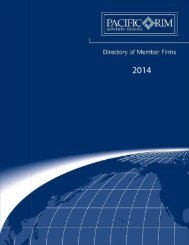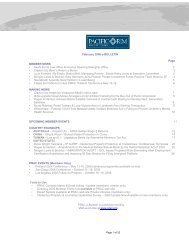A Guide to the Law of Securitisation in Australia - Clayton Utz
A Guide to the Law of Securitisation in Australia - Clayton Utz
A Guide to the Law of Securitisation in Australia - Clayton Utz
- No tags were found...
You also want an ePaper? Increase the reach of your titles
YUMPU automatically turns print PDFs into web optimized ePapers that Google loves.
have been completed <strong>in</strong> relation <strong>to</strong> <strong>the</strong> transferee Member, <strong>the</strong>transfer <strong>of</strong> funds for <strong>the</strong> transaction takes place <strong>in</strong> Reserve Bankfunds across exchange settlement accounts <strong>of</strong> <strong>the</strong> correspond<strong>in</strong>gParticipat<strong>in</strong>g Banks held with <strong>the</strong> Reserve Bank. A Participat<strong>in</strong>gBank can control its credit exposure <strong>to</strong> a client Member bysett<strong>in</strong>g a limit on <strong>the</strong> maximum debit balance <strong>of</strong> <strong>the</strong> Member’sCash Account with<strong>in</strong> <strong>the</strong> Austraclear System. The system doesnot allow transactions <strong>to</strong> be settled which breach <strong>the</strong> limit.Simultaneously, <strong>the</strong> Cash Accounts and <strong>the</strong> Security Records <strong>of</strong><strong>the</strong> relevant Members are updated <strong>to</strong> reflect <strong>the</strong> settlement <strong>of</strong><strong>the</strong> transaction.12.8.2 PaymentThe settlement <strong>of</strong> transactions <strong>in</strong> <strong>the</strong> Austraclear System isgoverned by regulations 14, 15 and 16. Under regulation 15,payment obligations are usually settled through RITS/RTGS. ThePayments System Board <strong>of</strong> <strong>the</strong> Reserve Bank has approved <strong>the</strong>Austraclear System as an “approved RTGS system” pursuant <strong>to</strong>section 9 <strong>of</strong> <strong>the</strong> Payment Systems and Nett<strong>in</strong>g Act 1998 (PSNAct). Accord<strong>in</strong>gly, pursuant <strong>to</strong> section 6(1), if a Member goes <strong>in</strong><strong>to</strong>“external adm<strong>in</strong>istration” and a payment or settlementtransaction is executed through <strong>the</strong> Austraclear System at anytime on <strong>the</strong> day on which <strong>the</strong> external adm<strong>in</strong>istra<strong>to</strong>r is appo<strong>in</strong>tedand <strong>the</strong> transaction <strong>in</strong>volves <strong>the</strong> payment <strong>of</strong> money or <strong>the</strong>transfer <strong>of</strong> an asset by <strong>the</strong> Member, that payment or transfer has<strong>the</strong> same effect it would have had if <strong>the</strong> Member had gone <strong>in</strong><strong>to</strong>external adm<strong>in</strong>istration on <strong>the</strong> next day. The PSN Act alsoprovides that section 6 has effect despite any o<strong>the</strong>r law.This ensures <strong>the</strong> irrevocability <strong>of</strong> completed Austracleartransactions by remov<strong>in</strong>g <strong>the</strong> application <strong>of</strong> <strong>the</strong> “zero hour rule”<strong>in</strong> <strong>the</strong> event <strong>of</strong> a Member’s <strong>in</strong>solvency. This rule provides that ajudicial act is taken <strong>to</strong> date from <strong>the</strong> earliest po<strong>in</strong>t on <strong>the</strong> day onwhich it occurs. Accord<strong>in</strong>gly, any disposition <strong>of</strong> property <strong>of</strong> <strong>the</strong>Member after this time on <strong>the</strong> day <strong>of</strong> <strong>the</strong> commencement <strong>of</strong> itsw<strong>in</strong>d<strong>in</strong>g up is void under section 468 <strong>of</strong> <strong>the</strong> Corporations Act.Without <strong>the</strong> PSN Act, any RTGS payment between midnight and<strong>the</strong> time that a w<strong>in</strong>d<strong>in</strong>g up order is made would be void. Thiswould result <strong>in</strong> no payment <strong>in</strong> Austraclear be<strong>in</strong>g presumed f<strong>in</strong>aluntil <strong>the</strong> end <strong>of</strong> <strong>the</strong> day on which it was made. Accord<strong>in</strong>gly, <strong>the</strong>Act ensures a completed RTGS transaction cannot be laterunwound if a Member is declared <strong>in</strong>solvent. Importantly,however, <strong>the</strong> PSN Act does not preclude <strong>the</strong> operation <strong>of</strong> section588FE <strong>of</strong> <strong>the</strong> Corporations Ac <strong>to</strong> permit a liquida<strong>to</strong>r <strong>to</strong> reclaimcerta<strong>in</strong> payments.12.8.3 Back-up settlement facilityIf for any reason RITS/RTGS is not operat<strong>in</strong>g, <strong>the</strong>re is a back-upfacility for settlement <strong>in</strong> place under regulation 16. This <strong>in</strong>volvesmultilateral nett<strong>in</strong>g between Austraclear, <strong>the</strong> Members andParticipat<strong>in</strong>g Banks. The Payments System Board <strong>of</strong> <strong>the</strong> ReserveBank has approved <strong>the</strong> Austraclear System as a multilateralnett<strong>in</strong>g system under <strong>the</strong> PSN Act where real time settlement isnot available. Pursuant <strong>to</strong> section 10(2), a party <strong>to</strong> an approvednett<strong>in</strong>g arrangement may do anyth<strong>in</strong>g permitted or required by<strong>the</strong> arrangement <strong>in</strong> order <strong>to</strong> net obligations <strong>in</strong>curred before or on<strong>the</strong> day on which it goes <strong>in</strong><strong>to</strong> external adm<strong>in</strong>istration. Section10(2)(e) provides that <strong>the</strong> nett<strong>in</strong>g and any payment made by <strong>the</strong>party under <strong>the</strong> arrangement <strong>to</strong> discharge a net obligation is notvoidable <strong>in</strong> <strong>the</strong> external adm<strong>in</strong>istration.12.9 ConclusionAustraclear plays a pivotal role <strong>in</strong> <strong>the</strong> issuance <strong>of</strong> debt securitiesand <strong>the</strong> clearance and settlement <strong>of</strong> securitisation transactions <strong>in</strong><strong>Australia</strong>. It provides an electronic trad<strong>in</strong>g and clear<strong>in</strong>genvironment, as well as cus<strong>to</strong>dy services, for debt securities.It encourages liquidity <strong>in</strong> <strong>the</strong> market, which is an essentialprecondition <strong>to</strong> participation by many <strong>in</strong>ves<strong>to</strong>rs.The Regulations and <strong>the</strong> Operat<strong>in</strong>g Manual provide <strong>the</strong> legalframework for <strong>the</strong> operations <strong>of</strong> Austraclear. The next section <strong>of</strong>this publication reviews <strong>the</strong> position <strong>of</strong> commercial mortgage–backed securities <strong>in</strong> <strong>the</strong> <strong>Australia</strong>n context.70






